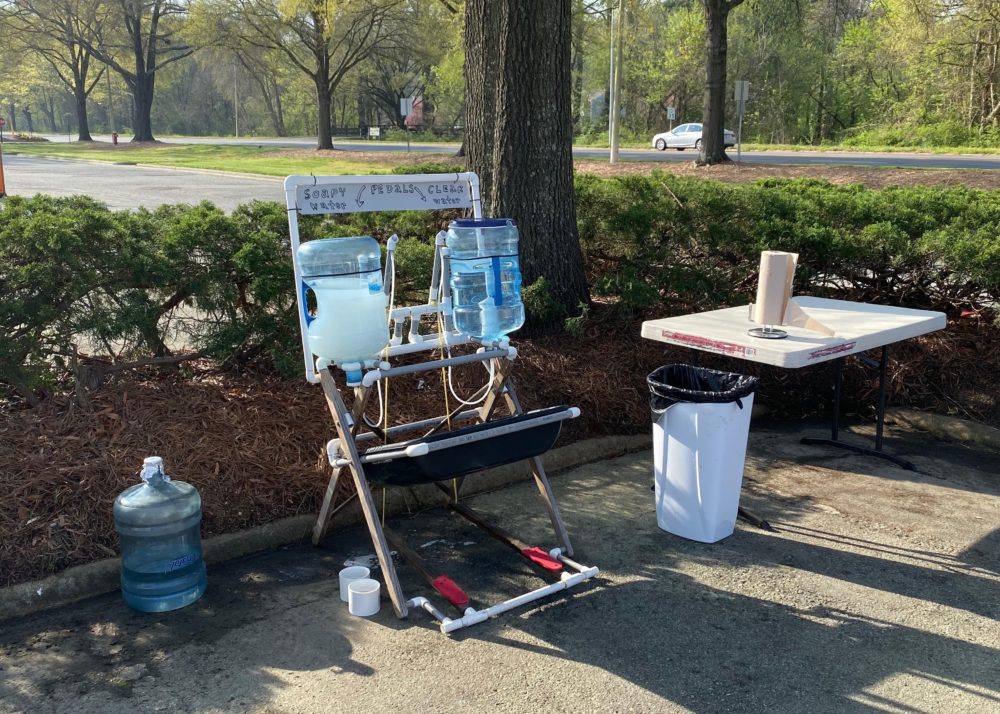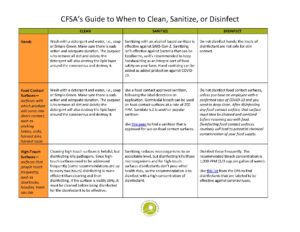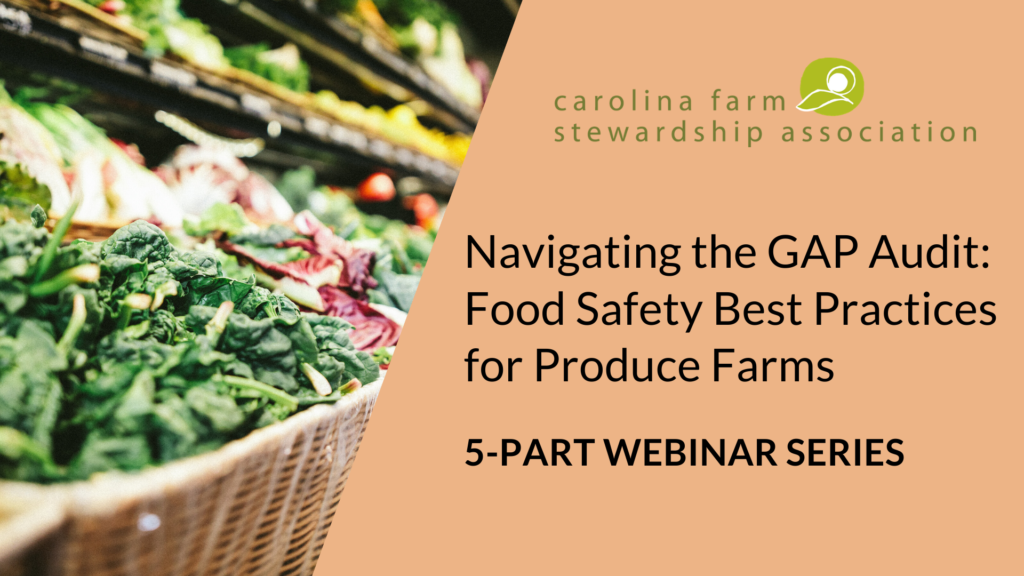by Chloe Johnson and Kim Butz, CFSA Local Produce Safety Coordinators | Tuesday, Apr. 7, 2020 –

If you are GAP certified or are following food safety best practices, then you are already protecting yourself, your workers, and your customers as best as we know how from the spread of this new viral threat. However, you need to add precautions specific to this virus that are coming down from your local departments of health, the CDC, and the FDA, such as social distancing. There are differences between COVID-19 and those foodborne viruses, which means you should follow slightly different protocols. You have the responsibility to stay up to date on the quickly emerging information and recommendations.
Below, we’ll cover:
- Best Practices for Avoiding Transmission
- COVID-19 Is Not a Foodborne Illness
- COVID-19 DOES Survive on Un-Disinfected Surfaces for a Somewhat Significant Amount of Time
- Recommendations for Cleaning and Sanitizing
- Resources to Check Often
- CFSA’s Upcoming Food Safety Webinar Series: Navigating the GAP Audit
Best Practices for Avoiding Transmission
First and foremost, food and food packaging are not known to be a route of transmission for the virus that causes COVID-19. Since the most serious risk of transmission is person-to-person contact (see below for more info on this), the biggest risk on your farm is not a transfer of COVID-19 to your customers but the spread of the virus among you and your employees (or any visitors to the farm). Our best practices for avoiding transmission this way are similar to basic food safety requirements, with the addition of recommendations for in-person contact from our local departments of health, the CDC, and the FDA. Some basic points to consider are below:
- Provide convenient handwashing stations and require frequent handwashing from anyone on-farm. Handwashing stations should be located outside so that workers arriving can wash their hands before they touch anything on the farm—a door handle, a harvest container, or gloves. Click here to learn how to build a very simple handwashing station for under $20.
- Limit visitors to your farm during this time. U-Pick operations will need to implement new policies that address the proper social distancing and limit the number of people on the farm to assure compliance. Please refer to NC State U-Pick Farm Guide for additional resources. Make sure any posted health and hygiene policies have been updated with COVID-19 recommendations. Visitors who aren’t customers picking up CSA boxes or participating in your U-Pick operation should not visit the farm during the pandemic (e.g., hosting a tour, stopping by to say hello, volunteers).
- Practice social distancing. Require that employees, volunteers, etc…. practice social distancing and stay the recommended 6–8 feet apart.
- Provide toilets and handwashing stations outside your home if you previously relied on your home bathroom for employee toilet breaks and handwashing.
- Consider splitting workers into two groups that do not come into contact with one another so that if one person gets sick, the risk of transmission is contained to half of your workforce.
- Strengthen your sick policies so that no employee or volunteer who is exhibiting symptoms of any sickness can report to work. Refer to guidance on employee/employer relationships to determine questions of requiring disclosure if employees have sick family members or housemates. “Best Practices of Conscientious Companies” is a good place to start (search for that phrase in this linked FAQ). Consider monitoring employee health (e.g., temperature checks).
- Continue with your regular cleaning and sanitizing schedule. Add a disinfectant schedule for high-touch surfaces (e.g., doorknobs, computers, trash can lids). If you don’t currently have a cleaning and sanitizing schedule for your farm, it is a great time to create and to begin using one.
- Don’t reuse packaging. All packaging should be new—including wax boxes, plastic bags, and clamshells.
- If you’re delivering food, selling at a farm stand, or if your farmers market is still open, refer to guidance on those types of retail establishments for best practices.
For a full explanation of food safety on farms, please join us for our Navigating the GAP Audit webinar series, which kicks off Monday, Apr. 13, 2020.
COVID-19 Is Not a Foodborne Illness
“Unlike foodborne gastrointestinal (GI) viruses like norovirus and hepatitis A that often make people ill through contaminated food, SARS-CoV-2, which causes COVID-19, is a virus that causes respiratory illness. Foodborne exposure to this virus is not known to be a route of transmission,” FDA Guidance on COVID-19.
The virus that causes COVID-19 has different characteristics than viruses that have been documented to transfer via consumption of contaminated produce. If consumed, it is assumed that the SARS-CoV-2 virus would be killed by your digestive system. Therefore, our best current understanding is that the biggest risk on a farm regarding the potential spread of COVID-19 is person to person transmission (employees in close proximity). There is a potential risk of the virus landing on an un-disinfected surface and surviving until someone touches it (and subsequently their face).
There are no known cases of SARS-CoV-2 spreading from food or food packaging to a person. However, that risk is not zero since the virus can survive on surfaces for a sustained amount of time (see below). Hypothetically, the virus could survive on a surface (such as a table or an eggplant) until someone touches it, and then touches their face—breathing in the virus. The virus must enter the respiratory tract to be infectious. See interviews with J. Kenji Lopez-Alt over at Serious Eats for a more detailed discussion about food safety and transmission of this virus.
An important note for food safety is that sustained high heat kills similar viruses. It is thought that sustained high heat will also kill COVID-19, but no studies have been completed and published on this as of yet. However, it is NOT thought that the virus would die if frozen. Most viruses can survive down to extremely low temperatures, and freezing is commonly used in labs to preserve viruses. This resource talks about this issue.
COVID-19 DOES Survive on Un-Disinfected Surfaces for a Somewhat Significant Amount of Time
A study found that SARS-CoV-2 had a four-day survival rate on un-disinfected surfaces. Another study was more specific on the types of surface and found that SARS-CoV-2 survives in the air for three hours, on plastics for 72 hours, on steel for 48 hours, and on cardboard for 24 hours. However, viruses cannot replicate on objects. Bacteria, for example, can replicate in the environment with or without a mammalian host. Therefore, if we clean, then sanitize or disinfect (whichever is appropriate) adequately, we will be effectively combating the virus.
It is very important to understand the differences between the following right now:
- Cleaning—using soap and water to scrub all dirt and debris off of a surface and then rinsing with water. Soap is effective against bacteria and viruses if washing is done properly (e.g., enough duration and enough friction from suds, scrubbing, or in the case of hands—rubbing hands together). If surfaces aren’t smooth, it’s more difficult to clean them properly.
- Sanitizing—treating a cleaned surface to reduce the number of microorganisms to acceptable levels. There are sanitizers that are approved for food-contact surfaces.
- Disinfecting—treating a cleaned surface to kill microscopic organisms as claimed on the label of the product. Reserve disinfectants for high-touch surfaces; disinfectants should not be used on food-contact surfaces.
Cleaning is always the first step; a surface that is not clean cannot be properly sanitized or disinfected. Sanitizing and disinfecting are effective against microorganisms, which are, by definition, incredibly small. If any dirt or debris remains on a surface, then a microorganism could survive under that dirt or debris and won’t be impacted by the sanitizer or disinfectant.
SARS-CoV-2 is surrounded by a lipid layer that is broken down by detergents or alcohol-based sanitizers. Traditional food safety recommendations are that handwashing is more effective than hand sanitizers and against some microbiological threats, which is true. However, for SARS-CoV-2, both handwashing and hand sanitizers are effective. Remember, we are concerned with COVID-19 now, but nonetheless need to remain vigilant against other foodborne microorganisms as well. Taking this into consideration, do not replace handwashing with hand sanitizing completely.
Recommendations for Cleaning and Sanitizing
For a great explanation of the virus and the differences and nuances of cleaning, sanitizing, and disinfecting, check out North Carolina State University’s webinar on Friday, April 3, “Best Practices for Small Farm Marketers During the COVID-19 Pandemic.”
You can also download CFSA’s Guide to When to Clean, Sanitize, or Disinfect (right).
Keep up with your routine cleaning and sanitizing schedule. If you don’t have such a schedule for your farm, contact us (CFSA’s food safety team) to get help developing one.
Hands should be properly washed at any time they could have become contaminated.
- At the start of work,
- After blowing one’s nose, coughing and sneezing,
- After assisting a visitor or customer,
- After each visit to a toilet,
- After handling contaminated material,
- After eating, or drinking,
- After breaks and prior to returning to work,
- After touching animals or waste.
Food-Contact Surfaces include packing tables, drying racks, harvest bins, harvest tools, sinks—any surface that comes into direct contact with fresh produce. These surfaces should be cleaned, then sanitized. You must use a sanitizer approved for food-contact surfaces at the recommended concentration. These surfaces should be cleaned and sanitized at least daily. Were you to have a case of COVID-19 among your staff or from a customer visiting the farm, it would then be appropriate to disinfect food-contact surfaces. However, after disinfecting, you must then clean and sanitize that food-contact surface before using in order to remove any potential chemical residue.
Non-Food Surfaces are surfaces that aren’t high-touch and don’t come into contact with fresh produce. Walls, storage containers, larger equipment are examples. These do not need to be cleaned and sanitized as frequently as food-contact surfaces. We recommend disinfecting these surfaces if someone on-farm was sick or had a confirmed case of COVID-19.
High-Touch Surfaces are surfaces that are touched by multiple people per day, many times per day. Examples include doorknobs, computers, handles, and trash can lids. High-touch surfaces or nonfood-contact surfaces should be cleaned and disinfected. These surfaces should be disinfected at least twice a day (dependent upon the number of people on your farm, some recommendations go up to disinfecting these surfaces every two hours).
It is recommended to use a bleach concentration of 1,000 PPM to be effective against coronaviruses on high-touch surfaces ONLY (five tablespoons of bleach to one gallon of water). DO NOT USE THIS CONCENTRATION ON YOUR HANDS OR on any FOOD-CONTACT SURFACE. A 200 PPM concentration is the correct strength for food-contact surfaces.
Note: Household bleach is not approved for food-contact surfaces but can be used on high-touch surfaces. Use germicidal bleach for food-contact surfaces if that is your sanitizer of choice.
When choosing sanitizers and disinfectants, use the following two tools:
- Produce Safety Alliance’s Sanitizer Excel Tool to determine what commercial sanitizer is best for your operation. This link is to a pdf that talks about choosing sanitizers generally, and includes a link for the actual excel searchable database for sanitizers. Keep in mind this list was made prior to the pandemic; its purpose was to help farmers find sanitizers that are EPA-approved, and to quickly determine if those sanitizers are also OMRI-approved and/or labeled for produce washing as well as food-contact surfaces. It was not designed to tell you if these products are effective against coronaviruses.
- The EPA has published a list for EPA-approved disinfectants and sanitizers that are considered effective against viruses. Note: This is NOT a list of food-contact surface-safe sanitizers. To determine what the substances are safe for, cross reference this list with resources from the Produce Safety Alliance (above).
Resources to Check Often
- FDA’s FAQ on Coronavirus and Food Safety
- United Fresh Coronavirus Industry Resource Page
- The Acheson Group’s COVID-19 and the Food Industry FAQ
- North Carolina State University Extension COVID-19 Resource Page
Want More? We’re Here to Help!
Attend CFSA’s Food Safety Best Practices for Produce Farms Webinar Series
CFSA’s food safety team is always hard at work helping farms to get GAP certified.
Join us for a five-week webinar series, starting Monday, April 13, 2020, where we’ll walk you through the ins and outs of becoming GAP certified in five 90-minute sessions.
Need advice or assistance right away? No problem, contact our local produce safety coordinators to get started:
- North Carolina: Chloe Johnson, chloe@carolinafarmstewards.org
- South Carolina: Kim Butz, kim@carolinafarmstewards.org.




